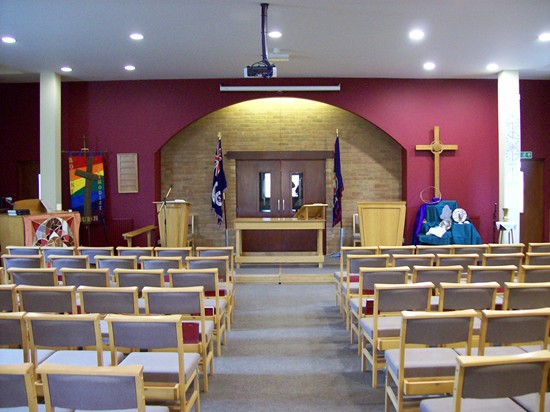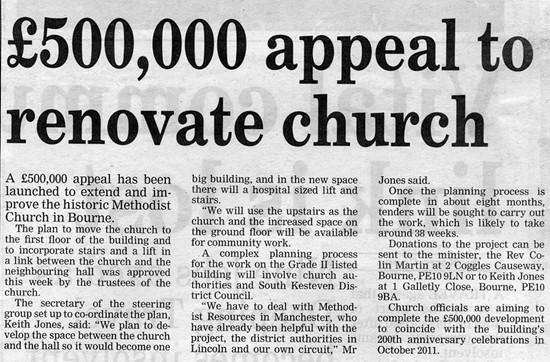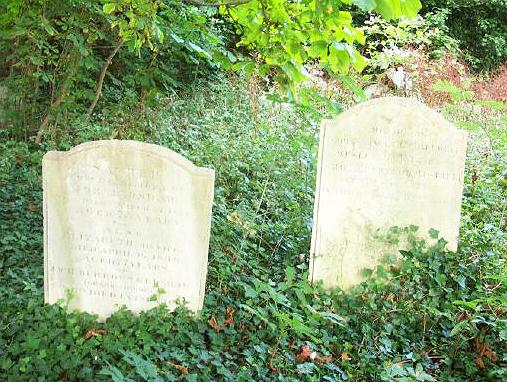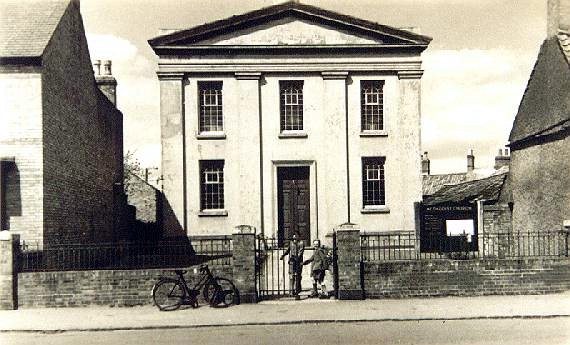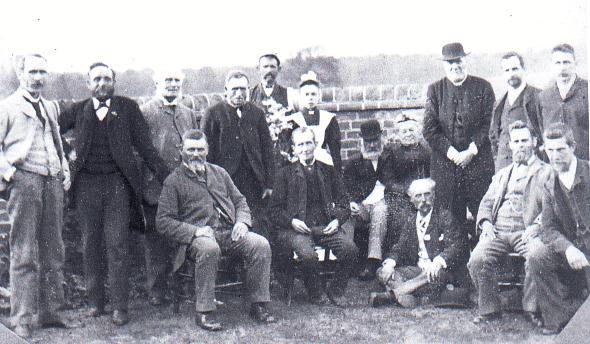|
The Methodist Chapel
Methodism came to Bourne from the village of Aslackby, seven miles north of the town, where the cause had been active since 1800. John Burrows and his wife had moved there from Skillington, near Grantham, and their preaching was so successful that local communities were soon established at Billingborough, Rippingale, Pointon and Bourne. John Wesley is reputed to have paid a visit to the town during a journey south in 1782 and found the seeds of support but it was more than a quarter of a century later before his evangelism took root. The Rev Thomas Cocking gives a graphic account of the steps some Christians took to encourage a Methodist ministry in the town in his book The History of Wesleyan Methodism in Grantham and its Vicinity (1836): In 1808, four men of Bourne, like unto Noah's dove, had no rest for the soles of their feet, nor could they find any in Bourn. At the Church there was an old man to minister, who delivered a sermon, ten minutes long only once every Sunday, and Jesus seldom mentioned. The Baptist Minister affirmed the Word was Spirit, and robbed us of our Comforter; and except we were baptised in their water and we could not be saved. We (the four men of Bourne) consulted and agreed to get the Methodists to come and preach to us, for the people around us were desperately wicked. Knowing the Methodists preached at Aslackby, we went on the preaching night. Mr Pollard, the Grantham minister, preached. We staid till the people were gone and then spoke to him, to know if we could be favoured with preaching at Bourne. I told him of our reasons as above. We informed him that we could engage a room and take as good care of him and his horse as our circumstances would admit. Accordingly, on 14th January 1809, Mr Pollard came, when I told him he had done well to come. We paid two shillings and sixpence a night for the room to preach in. The Minister and his horse were obliged to be at a public house, until the dear Comforter opened some more blind eyes, and they opened their houses to take him in. And I am persuaded that many have been born again under their ministry and are now singing in glory the praises of Him, of whom they had never seriously thought before the Methodists came to Bourne. The author of these words is not known but is believed to be John Redshaw (1761-1834), a saddler with premises in North Street, and as a result of the arrangements he and his three companions made, the minister subsequently stayed with one of them whenever he visited, usually with John and his wife Elizabeth, who became permanent hosts. The first meeting in Bourne was held in 1809 at a cottage in Star Lane, now Abbey Road, owned by John Brown, a convert to the faith and probably one of the "four men of Bourne" who claimed that his "blind eyes" had been opened. The cottage, rented by John Brown from the owner William Greasley, was probably situated on the present chapel's front garden. A Certificate of Preaching was granted in 1810 saying: "On the twenty third day of July 1810 a certain building, the property of William Greasley, situate in the parish of Bourne in the County and Diocese of Lincoln, was certified as a place of Religious worship for those of His Majesty's Protestant subjects dissenting from the Church of England commonly called Methodists." The movement grew rapidly, from just eight members in 1810 to sixty-five in 1815 and during the intervening period, a piece of land 12 yards by 10 yards was bought from William Greasley for £20 for the building of the first chapel. This land was well away from the main road and it has been suggested that the Methodists were unable to buy a site any nearer the road because of the prevailing hostile attitude towards non-conformity but this is unlikely because adjoining land was subsequently purchased bringing the property up to the pavement. A chapel was built and opened in 1812 at a cost of £200 and soon after Queen Victoria's accession in 1837, Bourne was placed at the head of the local circuit when the first ministers were the Rev J Waller and the Rev Thomas Bakewell. Mr Waller was described as "a fine gentleman of the genuine old Methodist type, very hearty but very eccentric". When it was discussed at the Methodist Conference who should go to the Bourne circuit, he said: "I will go if you will send my 'boy' with me." The "boy" was Thomas Bakewell and they worked together in harmony and with great enthusiasm but unfortunately, before a year had passed, Bakewell died of typhoid in 1839 at the age of 23, and is buried in the east end of the churchyard where a tombstone marks his grave. Mr Waller preached a deeply moving sermon at his passing based on the words: "As a son he hath served with me in the gospel". The congregation in the early days was sustained by a small group of families but they managed to raise the £135 needed to purchase more land between the chapel and Star Lane in 1828 with a view to building a larger chapel. A house in West Street was also bought in 1834 for £320 for the use of another preacher who was appointed by the Grantham Circuit to cope with an increasing workload of 200 Methodist members. Further land was purchased in 1841 for £21 and in the same year, the present chapel was built at a cost of £1,200 in what is now Abbey Road, with its façade of huge Doric pilasters. The work was carried out by Thomas Pilkington (1799-1889), one of the leading architects in the locality, and the building was opened the following year with a series of meetings over seven days when seven different preachers gave sermons, lead by the Rev Robert Newton, of Manchester, who spoke at the opening meeting on Wednesday 23rd March 1842. Collections were made after each meeting to help defray building costs and tea was provided afterwards on most days. "The Wesleyans promised their friends an intellectual feast at the opening of their new chapel", reported the Stamford Mercury on Friday 8th April, "and as far as the dedication services have proceeded, they have fully redeemed their pledge. Strength of intellect, justness of reasoning and sound divinity richly stored with the word of God, have been the traits of the sermons delivered by the eminent ministers who have preached on this interesting occasion." The chapel was registered as a Place of Religious Worship on 17th February 1854 and authorised for the solemnisation of marriages on 9th July 1862. A gallery was added to the new building in 1867, financed by Robert Munton in memory of his wife, and this increased the seating capacity of the chapel from 344 to 434. For some time, the choir and harmonium were situated there and for many years afterwards, the music at services was provided by the Redshaw family. Mr John Redshaw (1823-1895), grandson of John Redshaw, one of the "four men of Bourne", was the choirmaster and his daughter the organist, and there is a tale told that on one occasion, Mr Redshaw, from his position as choirmaster in the gallery, was clearly heard urging "the bottom singers not to drawl, but to try to keep up with the choir". During 1874, a new manse was built in North Road and this served as a home for the minister until the present one was built in Coggles Causeway in July 1971. Further improvement work was carried out in 1877 and the Stamford Mercury reported on Friday 18th May: The chapel has recently undergone considerable alterations. A modern platform has been erected instead of the old pulpit, the pews replaced by open seats, the ceiling and walls decorated and the chapel has now altogether a very improved appearance. The opening services were commenced on May 10th when the Rev T Champness, of Louth, preached in the afternoon and evening; and on the same day there was a public tea in the schoolroom. On the following Sunday, the Rev T H Brookfield, of Peterborough, preached in the morning and evening. The services are to be continued, the object being to raise funds the defray the expenses of the recent alteration which amount to about £200. Major restoration work was carried out in 1891 and special services were held to mark the completion of the ambitious project. The Stamford Mercury reported on Friday 12th June: The chapel has undergone a thorough renovation. The roof has been repaired and the rostrum has been altered to harmonise with the interior of the building. Over the two vestry doors have been painted floral scrolls. The pews on each side have been raised to the same level as the seats in the middle of the chapel. The ceiling and walls have been decorated, the blank windows being now adorned with texts of Old English characters. A floral text scroll also occupies the large arch behind the pulpit. The communion rail, vestry doors, the rostrum, and the vestibule have been finished in grained oak. The services, conducted by the Rev W H Johnson of Boston, were of an interesting character and hearty. The collections amounted to £5. The ladies' sewing meetings have proved a great assistance, about £20 having been thus collected. The painting, which has been entrusted to Mr Alfred Stubley [of West Street], and the woodwork, which has been placed in the hands of Mr Arthur Wall [of Abbey Road], have been admirably executed. To Mr John Wolstencroft, superintendent of the works, and to Mr Gill, great credit is due to the manner in which they have carried out their voluntary labours. Five cottages in Hereward Street were purchased for £510 in 1941 with a view to demolishing them to make space for extensions to the premises for the Sunday School, that had become an active part of the church's work. An annual report of 1888 indicates that there were 150 children enrolled in Bourne with 21 teachers attending both morning and evening sessions while 11 neighbouring villages also had similarly busy Sunday Schools. The old chapel remained in existence and served as a Methodist schoolroom for well over a century but was demolished in 1964 to make way for the present schoolroom and church hall. The new hall to seat 200 people with kitchen and toilet facilities was planned in 1953 and opened in two stages between 1958 and 1965. Other work included a start on the building of the caretaker's house, now known as Collins' House, built on the site of the old cottages in Hereward Street, and the provision of a new roof and heating system for the chapel itself for which additional money was raised by fetes and other activities. A stone-laying ceremony for the project was held on Saturday 9th January 1965 by Mr Harry Ringrose, a senior member of the church, with a short service of blessing in the church conducted by the minister, the Rev Cecil Day, assisted by the Rev Anthony Dent. Also built into the wall was an inscribed stone bearing the date 1812 that had been saved from the original building. Although the work had been estimated at £1,550, the final bill was more than £9,000 and the debt was not cleared until two years later. On Saturday 11th February 1967, a tablet was fixed to the wall of the church hall bearing witness to the donors and workers whose contributions had finally left the church free of debt. It was unveiled by the Rev Irving Scott, a former minister during whose time the project was initiated. The tablet said: In grateful acknowledgement of legacies bequeathed by Robert Arnold Collins, Ruth Ellen Collins and Annie Hunt, also of gifts made in memory of Philip and Doris Emson, John and May Ross, and a generous grant made by the Methodist Church Department for Chapel Affairs, raised by willing efforts of which together with funds members and friends defrayed the cost of building this hall. The Methodist Chapel in Abbey Road is now scheduled as a Grade II listed building and therefore cannot be demolished or altered without special permission at government level but in 1988, surveyors who checked the building declared that it was unsafe. The classical frontage was sound but closer inspection revealed that it had a tilt of six inches and the movement had affected the roof which, surprisingly, was made of corrugated asbestos. A report from consultant structural engineers said: "The chapel is in a potentially dangerous condition. The lateral movement of the southern wall has affected the roof. All main frames have been displaced and are significantly out of vertical. Action to restore the church to a safe condition for long-term worship will be an expensive operation. It is very difficult to be precise about the extent of this work without a more detailed study but the costs at this stage are estimated at between £50,000 and £100,000, plus VAT." The report alarmed church trustees who immediately applied to South Kesteven District Council for permission to demolish the chapel and build a new one elsewhere. The minister, the Rev Keith Town, said: "We are very attached to this building but Bourne is changing rapidly and we want to change with it. The church is people and we want a church for tomorrow and not for yesterday. If we repair the building, we want to do it thoroughly in order that future generations of worshippers will not find themselves in the same predicament." But the application was refused. The council ruled that all listed buildings should be preserved and that the answer to the church's predicament was repair rather than demolition. The case went to appeal but the council's decision was upheld by the Department of the Environment. The chapel was subsequently repaired and refurbished at a cost of £300,000 and remains in use.
The chapel was part of the Bourne Circuit of Churches until August 2008 when it was replaced by the new South Lincolnshire Circuit, thus bringing together several local churches including Bourne, Thurlby, Deeping St Nicholas and Market Deeping, under the superintendent minister, the Rev Colin Martin of Bourne. To celebrate the change, 120 people gathered at Bourne Methodist Church on Tuesday 12th August 2008, for a special service. Major changes to the church interior were announced in 2009 when it was decided to move the worship area to the first floor and develop the ground floor for increased community use. The £500,000 project would incorporate stairs and a lift and provide a link with the church hall next door, thus turning it into one large building. The work is expected to take eight months to complete.
REVISED MARCH 2014 See also John Wesley's visit to Bourne William Redshaw
Go to: Main Index Villages Index |
||||||||||||||||||||

